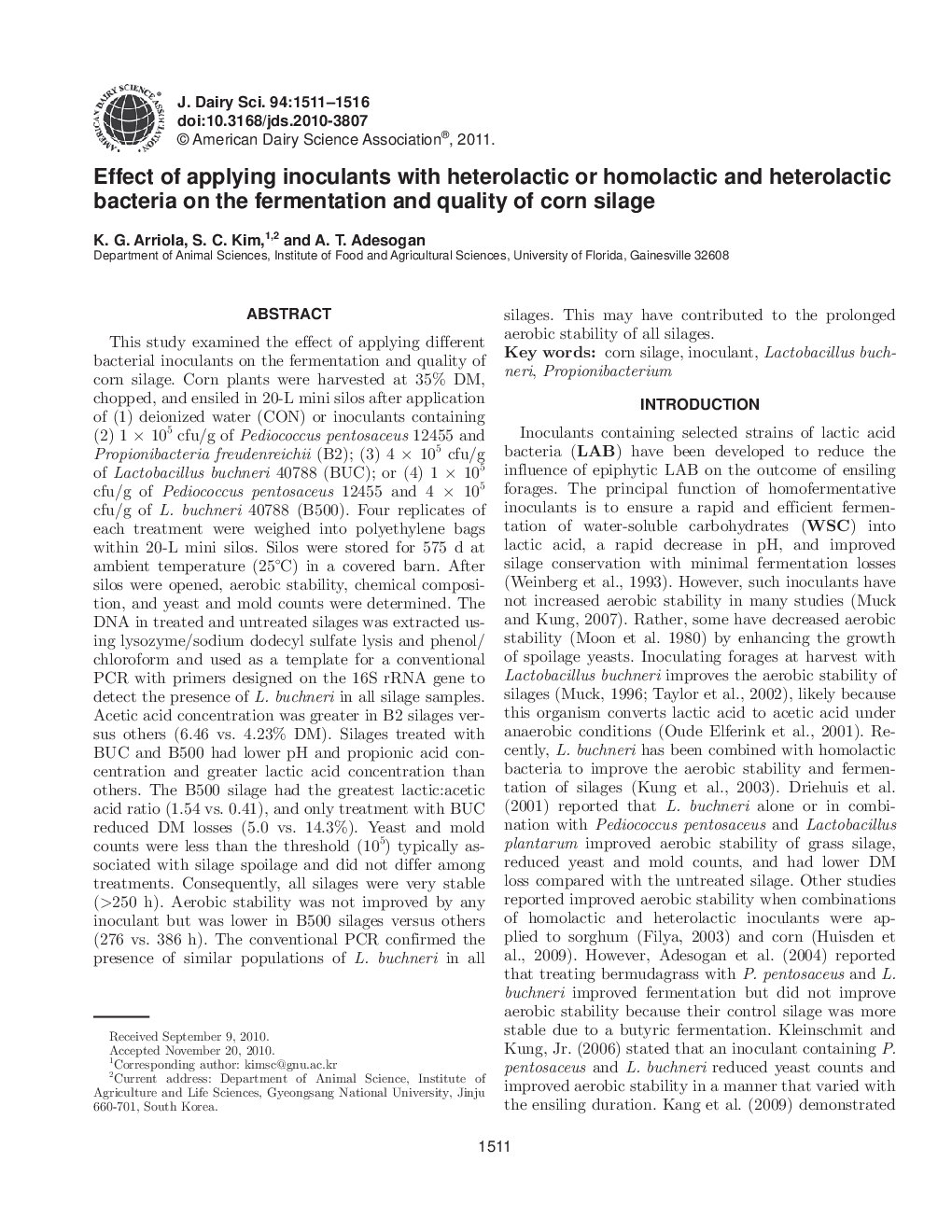| کد مقاله | کد نشریه | سال انتشار | مقاله انگلیسی | نسخه تمام متن |
|---|---|---|---|---|
| 10981431 | 1108076 | 2011 | 6 صفحه PDF | دانلود رایگان |
عنوان انگلیسی مقاله ISI
Effect of applying inoculants with heterolactic or homolactic and heterolactic bacteria on the fermentation and quality of corn silage
دانلود مقاله + سفارش ترجمه
دانلود مقاله ISI انگلیسی
رایگان برای ایرانیان
کلمات کلیدی
موضوعات مرتبط
علوم زیستی و بیوفناوری
علوم کشاورزی و بیولوژیک
علوم دامی و جانورشناسی
پیش نمایش صفحه اول مقاله

چکیده انگلیسی
This study examined the effect of applying different bacterial inoculants on the fermentation and quality of corn silage. Corn plants were harvested at 35% DM, chopped, and ensiled in 20-L mini silos after application of (1) deionized water (CON) or inoculants containing (2) 1 à 105 cfu/g of Pediococcus pentosaceus 12455 and Propionibacteria freudenreichii (B2); (3) 4 à 105 cfu/g of Lactobacillus buchneri 40788 (BUC); or (4) 1 à 105 cfu/g of Pediococcus pentosaceus 12455 and 4 à 105 cfu/g of L. buchneri 40788 (B500). Four replicates of each treatment were weighed into polyethylene bags within 20-L mini silos. Silos were stored for 575 d at ambient temperature (25°C) in a covered barn. After silos were opened, aerobic stability, chemical composition, and yeast and mold counts were determined. The DNA in treated and untreated silages was extracted using lysozyme/sodium dodecyl sulfate lysis and phenol/chloroform and used as a template for a conventional PCR with primers designed on the 16S rRNA gene to detect the presence of L. buchneri in all silage samples. Acetic acid concentration was greater in B2 silages versus others (6.46 vs. 4.23% DM). Silages treated with BUC and B500 had lower pH and propionic acid concentration and greater lactic acid concentration than others. The B500 silage had the greatest lactic:acetic acid ratio (1.54 vs. 0.41), and only treatment with BUC reduced DM losses (5.0 vs. 14.3%). Yeast and mold counts were less than the threshold (105) typically associated with silage spoilage and did not differ among treatments. Consequently, all silages were very stable (>250 h). Aerobic stability was not improved by any inoculant but was lower in B500 silages versus others (276 vs. 386 h). The conventional PCR confirmed the presence of similar populations of L. buchneri in all silages. This may have contributed to the prolonged aerobic stability of all silages.
ناشر
Database: Elsevier - ScienceDirect (ساینس دایرکت)
Journal: Journal of Dairy Science - Volume 94, Issue 3, March 2011, Pages 1511-1516
Journal: Journal of Dairy Science - Volume 94, Issue 3, March 2011, Pages 1511-1516
نویسندگان
K.G. Arriola, S.C. Kim, A.T. Adesogan,